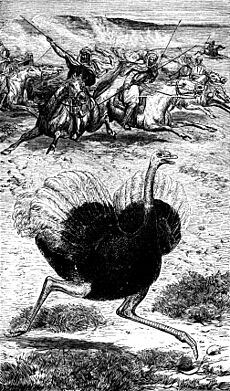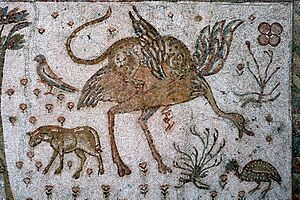Arabian ostrich facts for kids
Quick facts for kids Arabian ostrich |
|
|---|---|
 |
|
| Arabian ostrich painting from The Book of Animals by al-Jahiz. Syria, 14th century. |
|
| Conservation status | |
| Scientific classification |
|
| Kingdom: | Animalia |
| Phylum: | Chordata |
| Class: | Aves |
| Order: | Struthioniformes |
| Family: | Struthionidae |
| Genus: | Struthio |
| Species: | |
| Subspecies: |
†S. c. syriacus
|
| Trinomial name | |
| Struthio camelus syriacus Rothschild, 1919
|
|
The Arabian ostrich (Struthio camelus syriacus), also known as the Syrian ostrich or Middle Eastern ostrich, was a type of extinct subspecies of the ostrich. These large birds lived in the Arabian Peninsula and the Near East until the middle of the 20th century.
Contents
Where Did the Arabian Ostrich Live?
In ancient times, Arabian ostriches lived across a wide area. But as the Arabian Peninsula became drier, they disappeared from very harsh places like the Rub' al Khali desert.
In more recent history, these ostriches lived in two main areas. A smaller group was in the southeast of the Arabian Peninsula. A larger group lived where Saudi Arabia, Jordan, Iraq, and Syria meet today.
Ostriches were once common in the Israeli Negev desert. However, they died out there in the 1920s because of a lot of hunting. They were also found in Qatar, the United Arab Emirates (long ago), Oman, and Kuwait.
Scientists have studied the DNA of Arabian ostriches. They found that these birds were very closely related to the North African ostrich. This means they might have mixed with each other. The Arabian ostrich was a bit smaller than the North African one. This was the main way to tell them apart.
How Humans Interacted with Ostriches
The Arabian ostrich was important in the culture of the region for a very long time.
Ancient Times and Art
A famous ancient rock carving near Riyadh shows an adult ostrich with 11 young. In Mesopotamia, people used ostriches in religious ceremonies. They also featured in art, painted on cups and other items made from ostrich eggs. These items were traded far away, even to Etruria.
In Tang China, an ostrich was a special gift for an emperor. Ostriches are even part of the decorations at the Qianling Mausoleum, a tomb completed in 706 AD.
Religious Views

The Jewish view of the ostrich was not always positive. The Book of Job mentions that female ostriches might leave their nests. This is because their eggs are very tough and hard for predators to break. Because of this, the ostrich was seen differently from the stork, which protects its young. The Book of Lamentations even calls the female ostrich "heartless" for this reason.
The Arabian ostrich might be among the birds that Jews were forbidden to eat under kashrut laws in Leviticus. However, the Israelites might also have known the North African ostrich from Egypt.
Roman and Islamic Eras
During Roman times, there was a demand for ostriches. They were used in venatio games (public animal hunts) or for cooking. Most of these birds likely came from North Africa. However, later on, the feathers of the Arabian ostrich were thought to be better for hatmaking.
After Islam began, the Arabian ostrich became a symbol of wealth and style. Hunting ostriches became a popular hobby for rich and noble people. Ostrich meat is halaal (allowed) for Muslims if killed correctly. Ostrich eggs, feathers, and leather were widely used to make crafts. Arabian ostrich products, and even live birds, were sent as far as China.
A Chinese text from the Tang dynasty described the "camel bird" from Arabia. It said the bird was "four chi (about 1.2 meters) and more in height, its feet resembling those of a camel; its neck is very strong, and men are able to ride on its back...".
Scholars in Baghdad also wrote about the Arabian ostrich. These writings include Zakariya al-Qazwini's 'Aja'ib al-makhluqat wa-ghara'ib al-mawjudat and Al-Jahiz's Kitab al-Hayawan ("Book of Animals").
The famous writer T. E. Lawrence also mentioned the Arabian ostrich in his book Seven Pillars of Wisdom. He wrote about an Arabian tribe bringing ostrich eggs to Faisal I of Iraq as a sign of peace.
Why the Arabian Ostrich Became Extinct

The widespread use of firearms and, later, cars led to the decline and extinction of the Arabian ostrich. Before, hunting with bows, arrows, and dogs allowed many birds to escape. But rifles and cars made poaching (illegal hunting) and too much hunting possible. This caused the species to die out.
By the early 1900s, the Arabian ostrich was very rare. Its main home was in the northern An Nafud desert, stretching to the Syrian Desert. It was most common in Al Jawf Province. Here, it lived with herds of Saudi gazelle and Arabian oryx, which are now also extinct or very rare.
Some of the last sightings include:
- An ostrich seen near the Jordanian-Iraqi border in 1928.
- A bird shot and eaten by pipeline workers in the early 1940s.
- A dying ostrich found in Jordan in 1966.
Old egg remains are still found in the areas where the southern group of ostriches lived. This group disappeared between the 1900s and 1920s, likely due to increasing dry conditions.
Attempts to Bring Them Back
Scientists have studied the mtDNA of Arabian and North African ostriches. They confirmed how closely related these two types were. Because of this, a project began in Saudi Arabia and Qatar in 1994. The goal was to reintroduce ostriches using the North African subspecies. A similar attempt in Israel's Negev desert in 2004 was not successful.
See also
- Wildlife of Saudi Arabia
- South Asian ostrich
- East Asian ostrich



